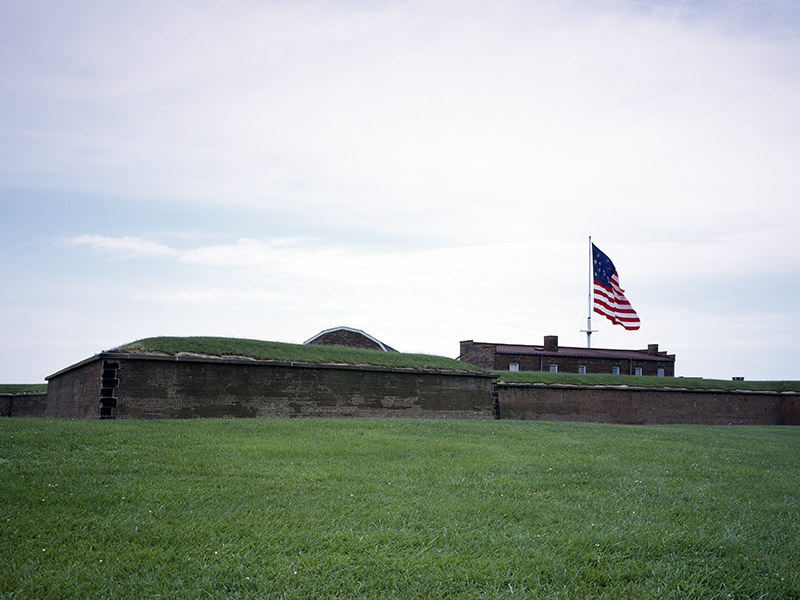| |
 |
| |
Fort McHenry, where the “Star Spangled Banner” was inspired by a battle in the War of 1812, Baltimore, Maryland.
Library of Congress (photo by Carol M. Highsmith).
|
As dawn broke on September 14, 1814, a haze of gunsmoke still hung over Baltimore Harbor, the result of a relentless 25-hour British bombardment that had lit the sky with fire and thunder through the night. But when morning light pierced the smoke, it revealed an inspired sight: a massive thirty-by-forty-two-foot American flag flying proudly over Fort McHenry, a First System Fortification (1794-1808) built in 1798 by the Army Corps of Engineers. Though the enemy fleet had hurled rockets and mortars in hopes of crushing the fort and capturing Baltimore, their aim was poor, and American defenses held strong. Sunken ships, well-placed cannons, and sheer determination kept the British from advancing. From a nearby ship, Francis Scott Key watched the flag rise—more than a morning custom, it was a bold signal of survival and defiance, proof that the young nation, though dearly tested, still stood. That morning, he penned the words to the “Star Spangled Banner,” later set to the tune of a popular British song and adopted as the national anthem.
The history of coastal defense in the United States reflects the evolution of military technology and strategic thinking over the course of two centuries. The nation’s vast coastlines, bordered by the Atlantic and Pacific Oceans, have long shaped its approach to defense. As historian Mark S. Smith, author of a comprehensive history of Army engineers and U.S. coastal defense (published by the USACE Office of History as Shield for the Republic: The U.S. Army Corps of Engineers and the Defense of the Coast, 1776-1950), explains, “For nearly 175 years after the nation’s establishment, the strategic defense of the United States meant securing its shoreline; the defense of the coast was the defense of the republic.”
While natural ocean barriers provided a degree of security, they also exposed the country to potential naval attacks. This vulnerability became evident during the War of 1812, when British forces blockaded ports, raided coastal settlements, and even set fire to Washington, D.C. In response, the U.S. government recognized the urgent need to establish a robust system of coastal fortifications, a task that fell largely to the Army Corps of Engineers. Over subsequent decades, these defenses evolved in response to technological advancements, shifting military strategies, and emerging threats.
 |
|
 |
|
Maj. Gen. Quincy Gillmore, 10 July 1863.
Library of Congress |
|
Fort Pulaski, Georgia |
|
The first major effort to secure the coastline came with the Third System of fortifications (1816-1867) in the early nineteenth century. The Corps of Engineers constructed an extensive network of stone and brick forts, designed to protect key ports and harbors. Notable examples include Fort Sumter in South Carolina, Fort Tompkins in New York, and Fort Pulaski in Georgia. These forts were built to withstand naval bombardment and deter enemy invasions. However, the Civil War exposed the vulnerabilities of these masonry forts, as the advent of rifled artillery made traditional fortifications increasingly susceptible to destruction. This was most famously demonstrated in 1862 during the siege of Fort Pulaski.
Located near Savannah, Georgia, Fort Pulaski was a Confederate stronghold guarding the Savannah River. Army engineer Maj. Gen. Quincy A. Gillmore led the Union attack under the command of Gen. Thomas W. Sherman. Rather than employing a traditional siege that could take weeks or months, Gillmore used newly developed rifled artillery, including powerful Parrott rifles. These advanced weapons, positioned to the south on Tybee Island, bombarded the fort from over a mile away, breaching its supposedly impregnable brick walls in just thirty hours. The accuracy and power of rifled artillery rendered masonry forts obsolete, forcing Confederate Col. Charles Olmstead to surrender on April 11, 1862. The fall of Fort Pulaski had significant strategic and symbolic consequences. The Union gained control of the Savannah River, effectively sealing off one of the South’s vital ports and crippling Confederate supply lines. Moreover, the success of Gillmore’s siege demonstrated that traditional coastal fortifications, which had been a mainstay of military defense for centuries, were no longer effective against modern artillery.
Recognizing the need for modernization, the presidentially appointed Endicott Board of Fortifications (1885) ushered in a new era of coastal defense with its findings and recommendations. Subsequently, Army engineers updated fortifications with reinforced concrete, disappearing guns, and electrically powered searchlights. This system was further refined in the early twentieth century by the Harbor Defense Board, which adapted defenses to counter new threats such as naval aviation and submarines. By World War II, coastal defense systems incorporated radar, anti-aircraft weaponry, and complex minefields, reflecting a shift toward more flexible and technologically advanced security measures.
 |
|
 |
Fort Jefferson, Florida, by Seth Eastman.
House of Representatives |
|
Fort Tompkins and Fort Wadsworth, New York, by Seth Eastman.
House of Representatives |
| |
|
|
Despite these advancements, the rapid evolution of warfare eventually rendered fixed coastal fortifications obsolete. The widespread use of air power and long-range missiles during and after World War II led to a strategic pivot toward antiaircraft systems, such as the Nike missile program. This shift emphasized the growing threat posed by aircraft, marking the end of traditional coastal fortifications, and once again the nation turned to the Corps of Engineers to construct the batteries, launchers, magazines, and other facilities.
For almost two centuries after the Revolutionary War, the Army Corps of Engineers not only protected vital harbors and American territory by constructing defenses from stone fortresses to missile batteries but also drove advancements in military engineering and bolstered national security. Although fixed coastal defenses have largely become a thing of the past, their legacy lives on in the nation's ongoing commitment to innovation and strategic adaptability in military defense.
| |
|
|
|
|
|
|
| |
|
 |
250th Anniversary
April 2025. No. 03. |
|
|
|
| |
|
|
|
|
|
|
|